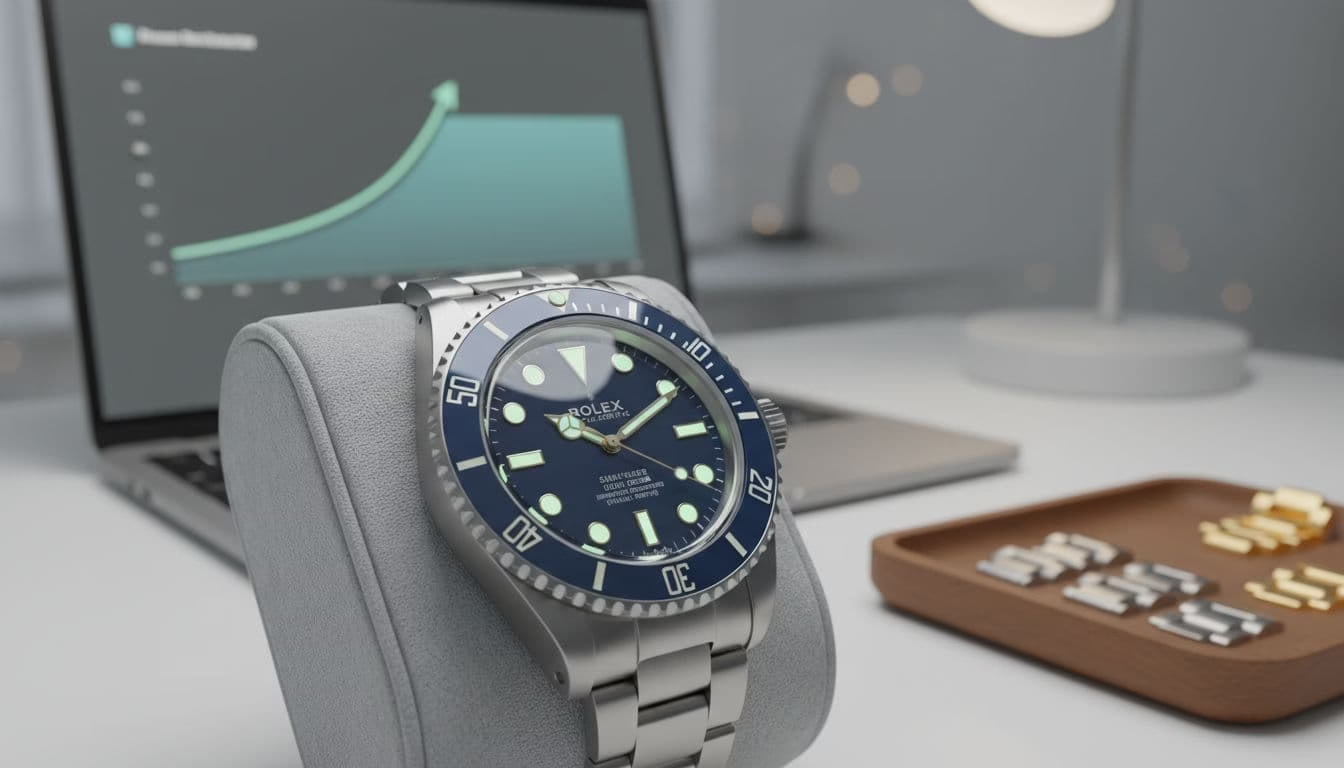Why do Rolex watches cost so much, and why do people still line up to buy these luxury watches? The short answer is the Rolex watch price stems from the cost to make the watch, and demand in the market. Both push prices higher and keep them there.
As of 2025, many Rolex steel models retail in the mid four to low five figures, think around 6,000 to 15,000 dollars. Solid gold models often start in the mid five figures and can go much higher, especially with diamonds. Values held up well after the 2021 to 2022 spike, but the market cooled a bit, so buyers should think in years, not months.
Here is what matters most. Materials and craft, scarcity and demand, brand power, and how to judge value for your budget.
What makes Rolex watches so expensive? Materials, craft, and testing
Rolex builds watches with premium parts and very strict processes. That drives cost. Each piece, from the highly engineered Daytona to other models, is designed to work hard, look clean, and last for decades, showcasing Rolex’s renowned craftsmanship.
- The brand uses 904L Oystersteel, not the more common 316L. It costs more, resists corrosion better, and takes a bright polish that looks different in the light.
- Rolex runs its own foundry for 18ct gold, including its proprietary Everose. Controlling the alloy mix improves color stability and purity. Gem models add hand setting, which takes extra time and skill.
- Parts like Cerachrom ceramic bezels, sapphire crystals, and Chromalight lume are expensive to make. Ceramics resist scratches and fading, sapphire is tough and clear, and long lasting lume costs more to produce.
- Movements are built in house, with tech like the Chronergy escapement, Parachrom hairspring, and Paraflex shock protection. These features improve efficiency, magnetism resistance, and durability.
- Double certification is standard. Movements pass COSC, then the full watch must meet Rolex Superlative Chronometer tests to about plus 2 or minus 2 seconds per day.
- Water resistance is tested for Oyster cases. Many dress and sport models are rated to 100 meters. Submariner hits 300 meters. Deep dive pieces add helium escape valves for saturation use.
- Human hands assemble, regulate, and inspect, with help from robotics for consistency. Swiss labor is expensive, and training is long.
Each step adds time, training, and strict quality control, which raises the final price.
Premium materials cost more, like 904L Oystersteel and in house gold
The Rolex Oystersteel case uses 904L Oystersteel, which has more nickel, chromium, and molybdenum than 316L. It resists saltwater and acids better, and it takes a crisp polish. It also costs more to buy and machine. Rolex’s craftsmanship shines in selecting such durable materials.
Rolex melts its own 18ct gold in yellow, white, and Everose varieties. Running a foundry lets the brand control purity and color. Tighter control raises quality and expenses.
Other costly parts matter too. Cerachrom bezels are hard to produce and color, sapphire crystals are tough but pricey, and Chromalight lume requires precise application and quality materials.
In house movements and strict accuracy tests add time and money
Building movements in house costs more than buying them. You need engineers, machines, and experienced watchmakers. The payoff is control over performance and supply, especially for Rolex’s advanced movement technology.
Movements first pass COSC tests. After that, the cased watch must meet the Superlative standard, which targets about plus 2 or minus 2 seconds per day. Power reserves in modern calibers often range from roughly 55 to 72 hours. The goal is stable timing, strong shock resistance, and solid resistance to magnetism, all enhanced by Rolex’s focus on precision.
These in-house innovations, including the Chronergy escapement, Parachrom hairspring, and Paraflex shock protection, deliver the precision that defines Rolex watches.
Waterproof cases and tough parts are built to last decades
The Oyster case uses a screw down crown and caseback with tight gaskets. Each watch is pressure tested. A Submariner is rated to 300 meters, which gives a big safety buffer for daily life. Strong seals, harder bezels, and thick sapphire help reduce failures. Longer lifespan and fewer defects raise up front costs, but they also cut headaches later.
Hand finishing and quality control reduce defects
Trained watchmakers assemble the movement and case, then test timing in several positions. They check the date jump, crown action, rotor noise, and finish. Any flawed part gets rejected and replaced. High rejection rates cost money, but they protect the brand’s reputation and the owner’s experience. Rolex’s craftsmanship in hand finishing ensures top quality, minimizing defects.
Rolex supply and demand: why scarcity drives prices up
Even with high output, demand is larger than supply. That simple math drives price and wait times.
- Rolex production grows slowly to protect quality. The public does not know the exact number, and capacity is limited by training and tooling.
- Authorized dealers handle allocations, so popular models can have long waitlists.
- The brand rarely does limited editions. Scarcity comes from careful Rolex supply control and slow, steady output.
- The resale market can add premiums on hot models. Prices spiked after 2021, then cooled in 2024 and 2025, yet many pieces still sit above retail.
- Taxes, import rules, and currency swings cause price gaps across regions.
Controlled supply and strong demand push prices higher at retail and especially on the secondary market.
Limited production and slow growth keep supply tight
Rolex scaling too fast risks quality. Precision machining and training take time. Growth stays measured, which keeps supply behind demand even as more buyers enter the market.
Authorized dealers control access and waitlists
ADs allocate hot models to clients. Building a relationship and purchase history can help. Many dealers use fair buying rules to spread out supply. This system shapes who gets new releases at retail price.
Resale market and hype push some models far above retail
Social media, celebrities, and collectors can spark sudden demand. Flippers add heat when prices rise fast. Since the peak, prices eased, but the most popular designs still carry premiums, and many buyers view Rolex as a strong investment for long-term holding. Value depends on the model, condition, age, and timing.
Rolex Certified Pre-Owned program shapes used prices
The Rolex Certified Pre-Owned program for pre-owned Rolex issues a dealer certificate and a Rolex-backed warranty, typically for two years. CPO watches often cost more than non-certified used pieces, but the trust and coverage of a certified authentic Rolex affect pricing across the market.
Brand power and history: why people pay more for Rolex watches
Parts and testing tell only part of the story. Brand equity adds value that you can feel and see, especially among luxury watches.
- Key milestones built trust. The waterproof Oyster case launched in 1926. The self-winding movement arrived in the 1930s. The Submariner debuted in 1953 and became the archetype dive watch.
- Designs like the Submariner, Datejust, GMT-Master II, Day-Date, Yacht-Master, Sky-Dweller, and Daytona stay familiar. Updates are steady and careful, which keeps them classic.
- Marketing is strong in tennis, golf, motorsport, and yachting. That keeps the Rolex brand in front of buyers.
- Swiss labor costs, research, strict regulations, and anti-counterfeiting work add overhead.
Heritage, trust, and status are real reasons buyers choose Rolex watches and accept higher prices.
A century of milestones builds trust and status
Start with the Oyster case in 1926, then the self-winding movement in the 1930s, then the Submariner in 1953. That steady record from Rolex lowers risk for buyers. People know what they are getting.
Consistent design makes icons like Submariner and Daytona
Designs evolve in small steps. Proportions, bezels, and dials shift slowly, so the watches age well. A classic silhouette is easy to spot across a room, which supports demand and value. Take the Rolex Day-Date 40, for example, a timeless piece in the Day-Date line.
Heavy investment in marketing, sports, and ambassadors
You see Rolex at Wimbledon, the Masters, Le Mans, and major sailing events. Global marketing raises costs, but it also keeps desire strong year after year, reinforcing Rolex’s standing worldwide.
Swiss labor, research, and compliance raise costs
Wages, training, labs, energy, and responsible sourcing standards all add to the bill. You pay for those inputs before any profit is counted.
Price versus value: are Rolex watches worth it for you?
Value is personal. Think about money, use, style, and how long you plan to keep the watch. Rolex offers diversification across models, from sporty options like the Explorer to elegant dress pieces like the Cellini.
- Resale and long term trends. Models like the Explorer and Yacht-Master hold value well. Some rise. Nothing is guaranteed, so buy for the long haul.
- Total cost of ownership. Plan for Rolex service every 7 to 10 years. Service can cost hundreds to over a thousand dollars, more for precious metal or gem-set models. Add insurance and safe storage if needed.
- Buying smart. New at an AD gives you retail price and full warranty, but expect a wait on popular pieces. Pre owned can be faster, so check serials, papers, service history, and condition. Only buy from trusted dealers.
- Alternatives. Tudor, Omega, and Grand Seiko offer strong movements, good finishing, and lower prices. Try them on the wrist and judge feel, weight, and comfort. For instance, Tudor’s robust designs echo the Explorer II’s sporty reliability, while Omega provides precision akin to the Milgauss’s specialized features.
A quick checklist:
- Budget set, including service and insurance
- Style picked, dress or sport, date or no date; consider the refined Cellini for formal occasions or the durable Sea-Dweller for water resistance and tough adventures
- Wrist size and comfort confirmed in person
- Retail or pre owned path chosen
- Dealer vetted, paperwork and warranty in hand
- Buy what you love first
Resale value and long term holding trends in 2025
Prices cooled from the peak, but top models like the Explorer still do well. Treat any gain as a bonus, not a plan. The best return is years of wear and joy.
Total cost of ownership, service, and insurance
Expect a service interval around 7 to 10 years, cost often in the mid hundreds to low thousands depending on model and work. Gold and gem pieces tend to cost more. Add insurance for theft or loss if the watch stretches your budget, and store it safely when not in use.
How to buy smart, new or pre owned, and avoid fakes
- Buy from ADs or respected dealers with strong reviews
- Check references, serial numbers, and paperwork
- Ask for service records and timing results
- Get an independent inspection if unsure
- Walk away from deals that look too good to be true
- Focus on authentic Rolex watches to ensure quality and avoid counterfeits
Rolex alternatives with similar quality at lower prices
- Tudor: shared heritage, robust movements, strong value
- Omega: METAS certified accuracy, deep catalog, rich history
- Grand Seiko: sharp finishing, smooth spring drive or high beat options, with impressive precision
Try watches on the wrist. Comfort and fit matter as much as specs.
Premium materials and testing, controlled supply, and brand power all help explain why Rolex costs so much. Many models hold value and can last for decades, but your price depends on the model and the market. Set a budget, pick a style that fits your daily life, such as the versatile Datejust or Rolex models for women, then visit an authorized dealer or a trusted pre owned seller. Buy the watch you will enjoy the most. That is the best value you can get.



